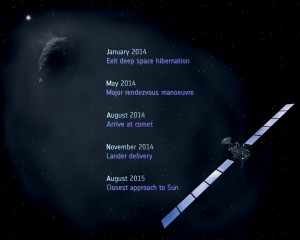
The Philae lander at work on Comet 67P/Churyumov-Gerasimenko. While Rosetta studies the comet from close orbit, Philae will obtain measurements from the surface. Credit: ESA/AOES Medialab
The European Space Agency’s (ESA) deep-sleep spacecraft – Rosetta — is due for a wake-up call in 100 days’ time.
Shot into space in early March 2004, the ESA probe is en route to comet 67P/Churyumov–Gerasimenko. Rosetta is an orbiter and lander mission, designed to show us more about the role of comets in the evolution of the solar system.
Rosetta’s internal alarm clock is set for 10:00 GMT on January 20, 2014.
Once it wakes up, Rosetta will first warm up its navigation instruments and then it must stop spinning to point its main antenna at Earth, to let the ground team know it is still alive and mission ready.
After wake-up, Rosetta will still be about 6 million miles (9 million kilometers) from the comet. As it moves closer, the 11 instruments on the orbiter and 10 on the lander will be turned on and checked.
A busy bird!
It has previously completed a complex series of flybys – three times past Earth and once past Mars. It also flew by and imaged two asteroids, Steins on September 5, 2008 and Lutetia on July 10, 2010.
In July 2011, Rosetta was put into deep-space hibernation for the coldest, most distant leg of the journey to its ultimate destination, comet 67P/Churyumov–Gerasimenko.
What’s ahead?
According to an ESA press statement, at the end May next year, Rosetta will execute a major maneuver to line up for rendezvous with the comet in August.
The first images of a distant 67P/Churyumov–Gerasimenko are expected in May, which will dramatically improve calculations of the comet’s position and orbit.
Closer in, Rosetta will take thousands of images that will provide further details of the comet’s major landmarks, its rotation speed and spin axis orientation.
By Leonard David

